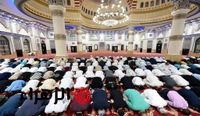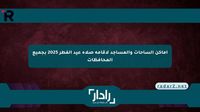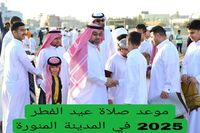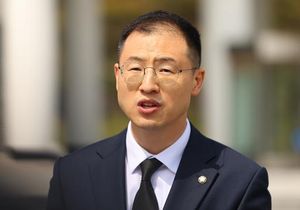As the holy month of Ramadan comes to a close, Muslims in Tunisia are gearing up for the Eid al-Fitr prayer in 2025, a significant religious observance that brings communities together in a spirit of joy and spirituality. Many are keenly searching for the timing of the Eid al-Fitr prayer for the year 1446 AH, eager to prepare and plan their activities for the festive day.
According to astronomical calculations, Eid al-Fitr in Tunisia is expected to fall on Monday, March 31, 2025, provided that the sighting of the Shawaal crescent moon is confirmed on the evening of Saturday, March 29, 2025. These preliminary estimates will await the official announcement from the Tunisian Astronomical Society in coordination with the Fatwa Office. The society has announced that it will utilize advanced techniques to accurately observe the moon, as it can be challenging to see with the naked eye. Should the sighting be confirmed on Saturday evening, Sunday, March 30, will be considered the last day of Ramadan, with Monday marking the beginning of Eid al-Fitr.
Timing for the Eid al-Fitr prayer has been officially confirmed, with sources indicating that the prayer will commence approximately 15 to 20 minutes after sunrise. In Tunis, the sun is expected to rise at 6:10 AM, making the estimated time for the Eid prayer around 6:15 AM. Due to the close timing across Tunisian cities, variations in prayer times are expected to be minimal. However, it is always advisable to refer to official announcements from the Fatwa Office or the Ministry of Religious Affairs before Eid.
The responsibility for announcing the date of Eid and the prayer time lies with the Tunisian Astronomical Society and the Tunisian Fatwa Office, which monitor the crescent moon using precise scientific methods. The Ministry of Religious Affairs will also issue an official schedule detailing the exact prayer times for each governorate in Tunisia.
The Eid al-Fitr prayer in 2025 is a confirmed Sunnah of the Prophet Muhammad (peace be upon him) and consists of two rak'ahs without an adhan or iqamah. The first rak'ah begins with the Takbir al-Ihram, followed by six additional takbirs, after which Surah Al-Fatiha and another surah, such as Surah Al-A'la or Surah Qaf, are recited. The second rak'ah starts with the Takbir standing, followed by five takbirs, and is concluded with Surah Al-Fatiha and either Surah Al-Ghashiyah or Surah Al-Insan. After the prayer, it is customary to deliver the Eid sermon, which is recommended to be attended.
Several Sunnah practices are encouraged during the Eid al-Fitr prayer, including: taking a bath and applying perfume, which is highly recommended; eating dates before the prayer, a confirmed Sunnah for Eid al-Fitr (not for Eid al-Adha); and engaging in Takbir, which starts from sunset on the last day of Ramadan until the prayer begins. It is also recommended to approach the prayer location by one route and return by another, and to perform the prayer in congregation, including women and children.
The Tunisian community is known for its rich traditions and customs during Eid al-Fitr, starting from the last night of Ramadan and continuing through the three days of celebration. Preparations often include cleaning and decorating homes in anticipation of the holiday, preparing traditional sweets and pastries, and purchasing new clothes for both children and adults.
On the first day of Eid, families gather for the Eid prayer in mosques or open squares, fostering a sense of communal joy and social connection. Following the prayer, families visit relatives and friends, exchanging greetings such as "Eid Mubarak" and "May Allah accept from us and you." Traditional dishes and sweets play an essential role in the festivities, with popular items including: Bessisa, Charmoula, Ghriba, and almond or date-filled pastries.
As Eid al-Fitr approaches, the importance of this prayer in the life of a Muslim cannot be understated. It serves as a vital aspect of Islamic tradition, showcasing the unity and joy of Muslims after completing their fast. It is a gathering that strengthens family bonds and revitalizes social connections among neighbors and acquaintances. The Eid prayer is not merely a religious duty but also a cultural and social event that embodies the spirit of togetherness.
In conclusion, the timing of the Eid al-Fitr prayer for 2025 marks a highly anticipated occasion for every Tunisian Muslim, symbolizing the joyful commencement of Eid al-Fitr and celebrating the end of Ramadan. This article aims to provide all necessary details regarding the prayer timing, performance, Sunnah practices, and the festive customs that characterize Tunisian society during this special occasion. It is recommended to closely monitor official announcements from the Fatwa Office and the Tunisian Astronomical Society to ensure accurate information regarding the date and timing of the Eid al-Fitr prayer in Tunisia.






